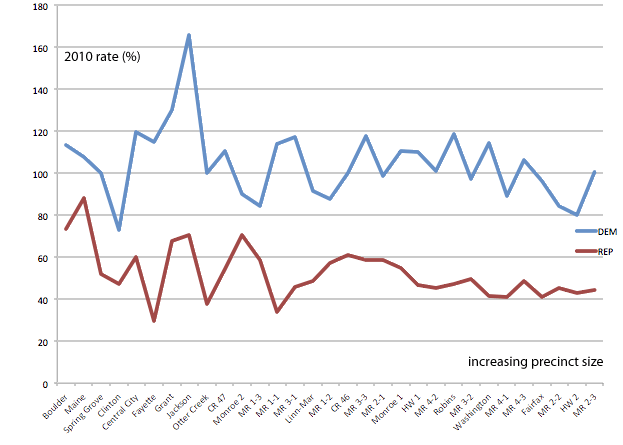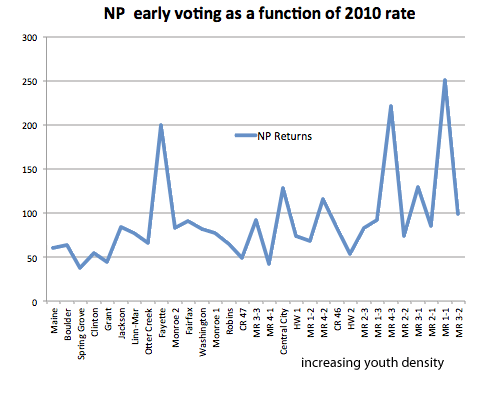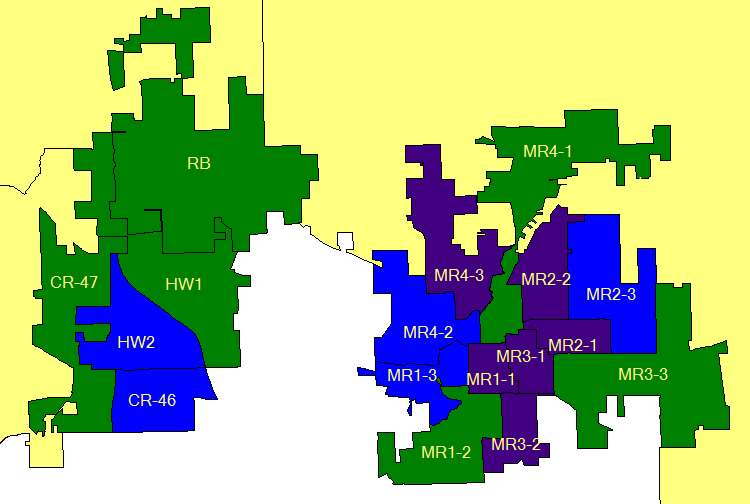The early voting numbers appear quite promising for Democratic candidate Liz Mathis. As of 2 November, the Democrats have exceeded their 2010 general election return total, while the Republican ballot requests (thus far) fall short of 2010 early voting, with a substantially larger lag in returns.

The ballot return numbers for Democrats and Republicans are displayed in order of increasing precinct size with percentages expressed relative to 2010. The volatility early in the series for the smaller precincts is not significant. All precincts are shown except for the “split” Cedar Rapids precincts that account for only a minuscule fraction of the electorate.
Based on the above, the relevant number is 2987 already banked for Democrats, just past their 2978 total in 2010. The Republicans, on the other hand, have not hit the 50% mark yet, with only 1426 banked compared to 2902 total in 2010. The number of Republican requests is 2066, 72% of their 2010 early voting total, so election day turnout will be critical for Cindy Golding's prospects.
The No Party “independent” returns are approaching 2010 levels with 1349 in as compared to 1528 cast in 2010. The precinct-level results are shown in order of increasing youth density, or number of voters in the 18-34 range normalized by precinct canvassing area:

The precinct-level view suggests that a successful effort is underway to galvanize younger independent voters to participate in this election. The key precincts to note are shown below in purple (very high value) and blue (high value), followed by green (medium) and yellow (low). In this context, “very high value” means the greatest density of youth voters. Note that this is very much a “shoe leather” exercise as this district does not have many obvious sources (colleges, trendy urban neighborhoods) to draw on beyond the Marion campus of Kirkwood Community College.

Note that all the large townships are (very) low-value targets. Central City (not shown) is medium (green).
The importance of the youth vote for Democrats cannot be overstated. Consider that the minority vote is almost non-existent. Only four precincts are below 90% White Non-Hispanic: Hiawatha 1 (84.9 2010 Census), Marion 4-3 (88.2) Cedar Rapids 46 (89.4) and Marion 1-3 (89.8).
Next, consider some of the head-to-head results of the 2010 election in this district:
Loebsack 47 Miller-Meeks 53
Mauro 46.5 Schultz 53.5
Culver 46 Branstad 54
Ternus retention: 53.4 NO
and compare, for example, to the 2008 result for IA-02:
Loebsack 55 Miller-Meeks 45.
A look at voter turnout by age group and party identification in 2010, relative to the 2008 electorate, shows clearly that the collapse in Democratic turnout was due to lack of Democratic/NP youth participation.

It is premature to extrapolate from the elevated Democratic and independent early voting trends, but by Monday, this post will be updated with turnout scenarios based on the final figures. At present, the numbers should be viewed as a hint at what is developing. Nevertheless, the poor GOP performance coupled to elevated Dem and NP returns in the more youthful precincts that posted some of the more favorable results for 2010 judicial retendtion bodes well for Democrats retaining the senate majority.

6 Comments
good diary
I will put it on the front page later today.
desmoinesdem Thu 3 Nov 8:28 AM
thanks for breaking things down
to the precinct level. Although the young voters may be less familiar with Mathis as a broadcaster, I would expect the youth vote to skew strongly toward Mathis, given how much commentary about this race has focused on the marriage issue.
Latest numbers at the close of business on November 3. 9,686 absentee ballots requested county-wide:
4,766 sent to registered Democrats (49.2 percent)
2,549 sent to Republicans (26.3 percent)
2,360 sent to no-party voters (24.4 percent)
Eleven sent to voters with some other registration.
7,048 ballots returned to the Linn County Auditor’s Office:
3,649 submitted by Democrats (51.8 percent)
1,878 from Republicans (26.7 percent)
1,515 from no-party voters (21.5 percent)
Six from voters with some other registration.
desmoinesdem Thu 3 Nov 6:51 PM
comments
I would expect the youth vote to skew strongly toward Mathis, given how much commentary about this race has focused on the marriage issue.
That’s one factor in my reasoning. The other one is that one party is rocking the early GOTV, the other is falling down on the job, so there’s no reason to believe that the value-added “unaffiliated” votes stem from the efforts of the latter. It makes sense to start building a cushion on top of matching + 2010 early voting.
I also think that canvassers on the ground vs negative mailers (NOM) is the more effective strategy.
Re: your question in the earlier post — the early voting participation rate for SD18 was lower than the statewide rate of ~ 1/3, closer to 1/4.
One thing I looked for at precinct level was signs of GOP GOTV efforts in precincts where the Mathis “name recc” value was lower for older voters as well. She left the station in 2007 + it takes some time to view a newscaster as a familiar, trusted face. I ranked the precincts based on growth since early 2000s. Given that voters in this district view themselves as swing-ish and independent-minded (thus less likely to vote early), if I were designing GOP strategy, I’d focus on the R-leaning areas w/ lots of growth, especially over the past five years to nail down some votes. Didn’t see evidence of a concerted effort. While GOP strategists might not agree w/ my approach, it was difficult to see their strategy: it is not based on volume, obviously, and if there’s a targeted strategy, it isn’t paying off yet.
albert Thu 3 Nov 7:20 PM
I don't understand their strategy
How hard is it to organize a bunch of volunteer or paid canvassers for five or six weekends in a row? Maybe they were counting on repeating their gains on the absentee front in 2010. That seems to have been accomplished mostly through mass direct mailings.
I am glad you weren’t designing GOP strategy!
desmoinesdem Thu 3 Nov 9:11 PM
bunch of things
First, we should recognize that this is a superlative Dem effort. Sue Dvorsky/IDP were criticized for 2010 performance, and I don’t think that’s unfair, but clearly she’s determined not to get caught off balance.
Also, I think the Dems want it more, and that’s important. Dems have to defend while the Republicans had a free gift handed to them by Gov Branstad’s actions. Like spoiled prats, they spent more time fighting over leadership than anything else. They could have taken care of that down the line, but it appears to me that Cindy Golding is sort of caught in the middle and doesn’t have a united effort behind her the way Mathis does. The anti-McKinley faction had no incentive to support her to victory since obviously they planned to hide behind crocodile tears while blaming McKinley. McKinley has now stepped aside, and it appears that the GOP is ramping up, but it might be too little to late. We’ll see over the next couple of days. I think I read today that Matt Schultz was phone-banking or something. LOL.
This was really about party vs party, not candidate vs candidate. One party worked, the other squabbled. That’s the way I see it.
Mathis is currently “not commenting” or returning calls on just about everything. To me, that’s the sign of someone who just doesn’t want to make a major mistake before Tuesday but otherwise feels pretty good. I didn’t care for her presentation, but one can see that it was also effective in that she didn’t rock any boats, which is probably just about perfect for a “moderate” district.
albert Thu 3 Nov 9:43 PM
interesting
ballots requested is now at the (1/3) of 2010 electorate level.
A very large turnout on polling day is prolly not good for the GOP. However, if the early voting represents a large fraction of the total electorate, it isn’t good for the GOP either.
albert Thu 3 Nov 9:24 PM